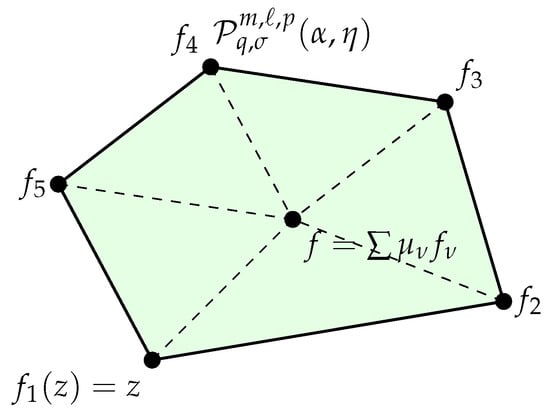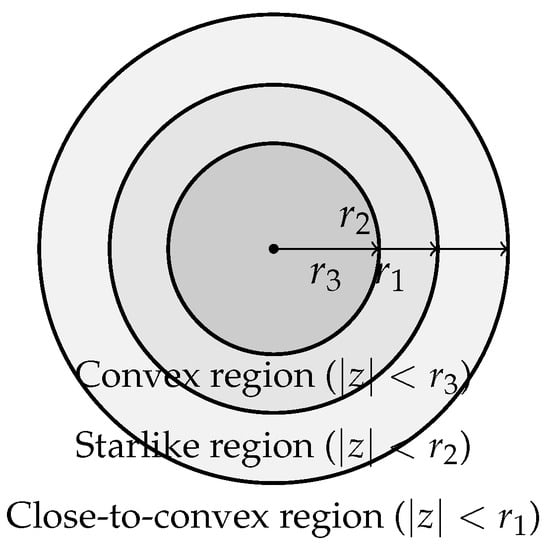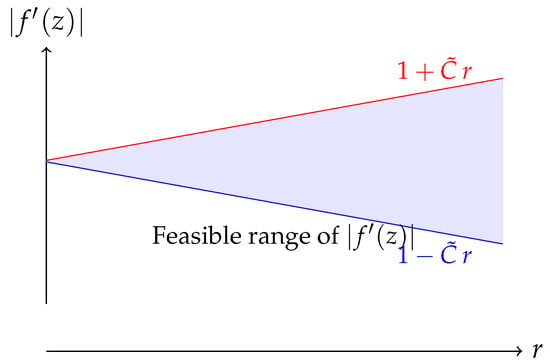Abstract
We introduce and analyze a subclass of analytic functions with negative coefficients, denoted by , constructed through a generalized q-calculus operator in combination with a multiplier-type transformation. For this class, we obtain sharp coefficient bounds, growth and distortion estimates, and closure results. The radii of close-to-convexity, starlikeness, and convexity are determined, and further consequences, such as integral means inequalities and neighborhood characterizations, are derived. The results presented provide a broad framework that incorporates and extends several earlier families of analytic and geometric function classes.
Keywords:
analytic functions; starlike andconvex functions; close-to-convex functions; integral means; neighborhoods; coefficient bounds MSC:
Primary 30C45; Secondary 26A24
1. Introduction and Definitions
The study of univalent, starlike, and convex mappings is a central theme in geometric function theory. Operator methods have proven especially effective in constructing subclasses of analytic functions and deriving coefficient bounds, growth estimates, and geometric properties. Over the years, various operators have been introduced in this context. Jackson [] laid the foundation of q-calculus by defining the q-derivative and q-integral, leading to a rich literature on q-extensions of classical operators (see [,,,]). Sălăgean [] introduced a differential operator which has since been adapted in numerous settings, while Frasin and Murugusundaramoorthy [] studied a generalized form. Later, Cho and Srivastava [] proposed a multiplier transformation operator that further broadened this framework.
To unify these developments, we consider a generalized operator that simultaneously extends the Jackson q-derivative, the Sălăgean-type q-operator, the Cho–Srivastava multiplier transformation, and related constructions. Let denote the family of functions analytic in the unit disk
normalized by and , so that each admits the expansion
The class of univalent functions in is denoted by .
For , the Jackson’s q-derivative of is defined by
which expands as
We now introduce the unified operator. For parameters , , , and , define
This formulation provides a common framework:
- Setting yields the Sălăgean q-operator, which generalizes the classical operator introduced by Sălăgean [].
- Setting gives the Cho–Srivastava multiplier transformation [].
- Setting gives the operator , which corresponds to the q-analogue of the Sălăgean differential operator studied in earlier works such as Frasin and Murugusundaramoorthy [].
- Letting reduces (4) to the corresponding classical operators.
The operator therefore serves as a unifying framework that connects and extends several well-known differential and multiplier-type operators in geometric function theory. This unified formulation not only encompasses previously studied cases but also paves the way for exploring new subclasses of analytic functions within the broader q-calculus setting.
A function is said to belong to the class if
We also consider the subclass
and finally define
In the sections that follow, we investigate coefficient bounds, growth and distortion theorems, radii of starlikeness and convexity, closure properties, integral means inequalities, and neighborhood results for the class .
2. Coefficient Estimates
This section provides coefficient bounds for functions in the class by first giving a necessary and sufficient condition for membership.
Theorem 1.
Let be given by (1). Then if and only if
The inequality is sharp.
Proof.
Suppose . Then, by definition,
Expanding the numerator, we obtain
Similarly, the denominator expands as
Hence, condition (9) is equivalent to
Letting along the real axis, we deduce
which rearranges to (8).
Conversely, if (8) holds, then for , we have
Hence, .
Finally, the equality in (8) is attained for the extremal function
□
3. Inclusion Relations
This section is devoted to several basic inclusion results concerning the family .
Theorem 2.
Let , , and . Then,
Proof.
Hence,
This verifies the inclusion (12). □
Theorem 3.
Let , , and . Then
Proof.
Assume belongs to . Then, by Theorem 1,
This establishes the assertion. □
Theorem 4.
Let , , and . Then
and
Proof.
Both inclusions follow from Theorem 1 by observing the monotonic dependence on the parameters ℓ and m. □
Corollary 2.
For , , and , the following chain of inclusions holds:
Thus, increasing η, α, m, or ℓ yields smaller subclasses nested within one another.
Remark 1.
The inclusions in Theorems 2–4 show that the parameters η, α, m, and ℓ act as monotonic complexity indices: larger parameter values correspond to smaller subclasses nested within the family . This hierarchical structure parallels many classical results for analytic function classes, but here it is extended to the generalized q-calculus setting.
4. Growth and Distortion Theorems
In this section, we establish sharp growth and distortion bounds for functions belonging to the class . These results extend the well-known growth and distortion estimates for starlike functions with negative coefficients to a broader q-calculus framework involving the unified operator . The bounds derived here not only quantify the behavior of functions in the unit disk but also highlight the extremal functions that realize equality.
Theorem 5.
Proof.
Note that if and only if
and
By Theorem 1, we obtain
which implies
Remark 2.
If one takes the limiting case , , , the inequalities (18) and (19) reduce to the classical growth and distortion bounds
which are well known for the family of starlike functions with negative coefficients. Thus, Theorem 5 extends these classical results to the broader q-calculus setting with additional parameters.
5. Closure Theorems
In this section, we establish that the family enjoys certain closure properties under convex combinations.
Theorem 6.
The class is convex.
Proof.
Let
be two functions in . Consider their convex combination
Clearly,
By Theorem 1, one has
showing that . Thus, the class is convex. □
Theorem 7.
Let and, for , define
Then, a function belongs to if and only if it can be expressed as
where and .
Proof.
It follows that
Hence, by Theorem 1, .
Conversely, suppose lies in . Then, by Theorem 1,
Define
and
Then , , and f has the representation (27). □
Remark 3.

Theorem 7 shows that the class coincides with the closed convex hull of the extremal functions . In particular, every function in can be realized as a convex combination of the extremal members , with and of the form specified in Theorem 7. This characterization provides not only a constructive description of the class but also a useful tool for deriving further extremal problems, see Figure 3.

Figure 3.
Geometric interpretation of Theorem 7: the class is the closed convex hull of its extremal functions . Every member f can be realized as a convex combination of these extremals.
6. Radii of Close-to-Convexity, Starlikeness, and Convexity
In the theory of analytic functions, particular attention has been devoted to certain important and well-investigated subclasses that play a central role in geometric function theory. Among these, the classes of convex, starlike, and close-to-convex functions are of special significance due to their rich geometric and analytic properties.
For all and some , the classes of convex , starlike , and close-to-convex functions are defined, respectively, as
In this section, we determine the radii within which members of preserve the geometric properties of close-to-convexity, starlikeness, and convexity of order .
Theorem 8.
Let of the form (1) belong to . Then, f is close-to-convex of order β in , where
The result is sharp, with the extremal function given by (10).
Proof.
To guarantee close-to-convexity of order , it suffices to show
Since
we obtain
Thus, the condition
is sufficient. Using Theorem 1, this inequality holds whenever
which yields (28). □
Theorem 9.
Let of the form (1) belong to . Then f is starlike of order β in , where
The result is sharp, with extremal function given by (10).
Proof.
To ensure starlikeness of order , one requires
From (1),
Thus the condition
is sufficient. Applying Theorem 1, this inequality holds whenever
which gives (29). □
Corollary 5.
If belongs to , then f is convex of order β in , where
The result is sharp, with the extremal function given by (10).
Remark 4.

The radii obtained above satisfy the natural hierarchy
which reflects the inclusions among the corresponding subclasses of analytic functions: every convex function is necessarily starlike, and every starlike function is close-to-convex. Thus, the values of precisely quantify the largest disks in which these geometric properties are preserved for members of , see Figure 4.

Figure 4.
Nested disks illustrating for .
7. Integral Means Inequality
In geometric function theory, integral means inequalities provide valuable tools for comparing the size of analytic functions and their extremal counterparts in the unit disk. These inequalities are closely tied to the concept of subordination, which allows one to transfer growth properties from a dominant function to a subordinate one.
Recall that for analytic functions f and g in , we say that f is subordinate to g in , written , if there exists a Schwarz function analytic in with
such that for all . When g is univalent in , the following equivalence holds []:
We shall also use the following fundamental result of Littlewood [], which connects subordination with -norm inequalities.
Lemma 1.
If f and g are analytic in Ω with , then for every and ,
The next theorem applies Lemma 1 to functions in our class, showing that their integral means are maximized by a specific extremal function.
Theorem 10.
Assume the sequence
is nondecreasing. If , then for and ,
where the extremal function is given by
Proof.
Let . To establish (32), it suffices to prove the subordination relation
To verify (34), define by
Clearly, . Moreover, by Theorem 1,
Thus, is a Schwarz function, which proves the desired subordination (34). Applying Lemma 1 completes the proof. □
Remark 5.
Theorem 10 shows that the extremal function of the form (33) dominates the integral means of every member of . In particular, for , this gives sharp -norm estimates. Moreover, in the limiting case , , , and , the result reduces to the classical integral means inequality for the family of starlike functions with negative coefficients.
8. Neighborhood Results
The concept of neighborhoods of analytic functions plays a central role in geometric function theory, as it provides a framework to measure how perturbations of the coefficients affect membership in a given subclass. This notion was first introduced by Goodman [] and later generalized by Ruscheweyh []. In particular, neighborhood results ensure that classes of analytic functions are stable under certain controlled variations, which is crucial for understanding extremal problems, approximation properties, and robustness of geometric features such as univalence or starlikeness.
In this section, we investigate -neighborhoods associated with the family .
For a function of the form
the -neighborhood of f is defined by
In particular, when f is taken to be the identity mapping , this reduces to
Thus represents the collection of all functions lying within a -neighborhood of the identity in terms of their coefficient deviations.
8.1. Neighborhood of the Identity Function
We begin with the following result, which shows that the entire class is contained in a specific neighborhood of the identity mapping.
Theorem 11.
If
then
8.2. Neighborhood of a General Function
We next extend the discussion to neighborhoods centered at an arbitrary member of the class. In this context, a function for some is said to belong to if
Theorem 12.
Let . If
then
Proof.
Since , we also know from (41) that
Letting , we find
where is chosen as in (42). This shows , completing the proof. □
Remark 6.
Theorems 11 and 12 demonstrate that the class admits a robust neighborhood structure compatible with the δ-framework. Specifically, Theorem 11 ensures that every function in the class lies in a prescribed neighborhood of the identity, while Theorem 12 shows that neighborhoods of arbitrary functions remain stable within the class under suitable constraints on δ and ε. These results underline the geometric stability of the class and extend the classical neighborhood theory of Goodman and Ruscheweyh to the unified q-calculus setting.
9. Conclusions
In this paper, we introduced and investigated the unified class , which is defined through the generalized operator . This operator simultaneously extends the Jackson q-derivative, the Sălăgean-type operator, and the Cho–Srivastava multiplier transformation, thereby providing a comprehensive framework that encompasses and generalizes several classical families of analytic functions with negative coefficients.
We established sharp coefficient estimates for the class and determined the associated extremal functions. Various inclusion relations were derived, showing the nested structure of subclasses that arise as the parameters vary. Growth and distortion theorems were obtained, extending well-known classical bounds to the broader q-calculus setting. Closure properties were analyzed, demonstrating that the class is convex and coincides with the closed convex hull of its extremal functions. The radii of close-to-convexity, starlikeness, and convexity were explicitly determined, and their natural hierarchy was highlighted. Further results included integral means inequalities derived via subordination techniques and a study of neighborhoods in the sense of Goodman and Ruscheweyh, which confirmed the stability of the class under suitable perturbations.
These findings not only unify and extend earlier results in geometric function theory but also establish a versatile operator framework for future investigations. Possible extensions include the study of bi-univalent subclasses associated with the operator , the derivation of sharp Fekete–Szegő inequalities and Hankel determinant bounds, as well as the analysis of convolution properties and integral transform relations. The present work therefore contributes to the continuing development of q-calculus methods in geometric function theory and opens new avenues for further exploration.
Author Contributions
Conceptualization, M.I. and F.Y.; methodology, M.I.; validation, M.I. and F.Y.; formal analysis, M.I.; investigation, M.I. and F.Y.; writing—original draft preparation, M.I.; writing—review and editing, F.Y. All authors have read and agreed to the published version of the manuscript.
Funding
This research received no external funding.
Data Availability Statement
The original contributions presented in this study are included in the article. Further inquiries can be directed to the corresponding author.
Acknowledgments
The authors express their gratitude to the anonymous reviewers for their valuable comments and suggestions, which significantly enhanced the quality of this work.
Conflicts of Interest
The authors declare no conflicts of interest.
References
- Jackson, F.H. On q-functions and a certain difference operator. Trans. R. Soc. Edinb. 1908, 46, 253–281. [Google Scholar] [CrossRef]
- Illafe, M.; Mohd, M.H.; Yousef, F.; Supramaniam, S. A subclass of bi-univalent functions defined by a symmetric q-derivative operator and Gegenbauer polynomials. Eur. J. Pure Appl. Math. 2024, 17, 2467–2480. [Google Scholar] [CrossRef]
- Aral, A.; Gupta, V.; Agarwal, R.P. Applications of q-Calculus in Operator Theory; Springer: New York, NY, USA, 2013. [Google Scholar]
- Kanas, S.; Răducanu, D. Some class of analytic functions related to conic domains. Math. Slovaca 2014, 64, 1183–1196. [Google Scholar] [CrossRef]
- Vijaya, K.; Murugusundaramoorthy, G.; Yalçin, S. Certain class of analytic functions involving Salagean type q-difference operator. Konuralp J. Math. 2018, 6, 264–271. [Google Scholar]
- Sălăgean, G.S. Subclasses of univalent functions. In Complex Analysis: Fifth Romanian-Finnish Seminar; Springer: New York, NY, USA, 1981; pp. 362–372. [Google Scholar]
- Frasin, B.A.; Murugusundaramoorthy, G. A subordination results for a class of analytic functions defined by q-differential operator. Ann. Univ. Paedagog. Cracoviensis Stud. Math. 2020, 19, 53–64. [Google Scholar] [CrossRef]
- Cho, N.E.; Srivastava, H.M. Argument estimates of certain analytic functions defined by a class of multiplier transformations. Math. Comput. Modelling 2003, 37, 39–49. [Google Scholar] [CrossRef]
- Illafe, M.; Hussen, A.; Mohd, M.H.; Yousef, F. On a subclass of bi-univalent functions affiliated with Bell and Gegenbauer polynomials. Bol. Soc. Parana. Mat. 2025, 43, 1–10. [Google Scholar] [CrossRef]
- Littlewood, J.E. On inequalities in theory of functions. Proc. Lond. Math. Soc. 1925, 3, 481–519. [Google Scholar] [CrossRef]
- Goodman, A.W. Univalent functions and nonanalytic curves. Proc. Am. Math. Soc. 1957, 8, 598–601. [Google Scholar] [CrossRef]
- Ruscheweyh, S. Neighborhoods of univalent functions. Proc. Am. Math. Soc. 1981, 81, 521–527. [Google Scholar] [CrossRef]
Disclaimer/Publisher’s Note: The statements, opinions and data contained in all publications are solely those of the individual author(s) and contributor(s) and not of MDPI and/or the editor(s). MDPI and/or the editor(s) disclaim responsibility for any injury to people or property resulting from any ideas, methods, instructions or products referred to in the content. |
© 2025 by the authors. Licensee MDPI, Basel, Switzerland. This article is an open access article distributed under the terms and conditions of the Creative Commons Attribution (CC BY) license (https://creativecommons.org/licenses/by/4.0/).

